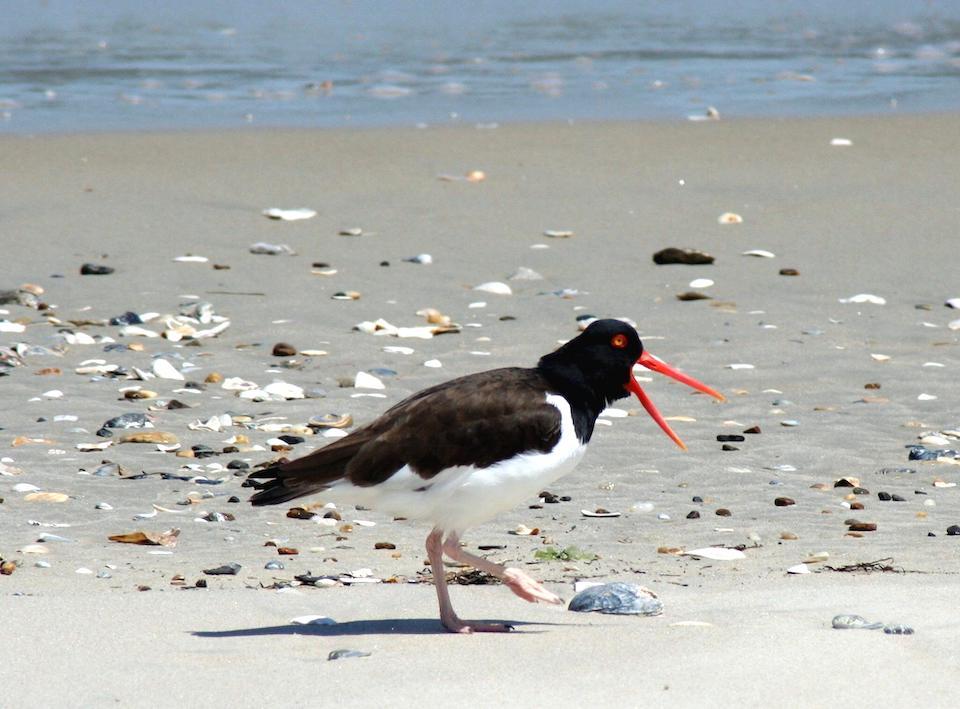
Restricting human access at Cape Hatteras National Seashore benefits shorebirds and sea turtles, according to researchers/NPS file
A study of wildlife and humans at Cape Hatteras National Seashore on North Carolina's Outer Banks shows that restrictions of where visitors to the seashore can go help wildlife, particularly shorebirds.
Park managers strive to integrate the needs of wildlife with recreational use of the area's beaches, but in some cases, they impose restrictions on human visitors to preserve the former--sometimes even completely closing portions of beaches to pedestrian and off-road vehicle traffic to protect nesting birds, noted the researchers in a report prepared by the American Ornithological Society. These closures are controversial, the researchers noted, but there's evidence that despite complaints from the public, the restrictions provide significant benefits for vulnerable beach-nesting birds and sea turtles.
Two such beach-nesting birds--the American Oystercatcher and federally threatened Piping Plover--are of particular concern to seashore managers. Populations of both species at Cape Hatteras declined in the late 1990s and early 2000s. The plover population recovered to pre-decline levels, whereas the oystercatcher population did not. In 2016, in response to the ongoing controversy over beach closures in the park, the National Park Service asked the ornithologial society to assemble an expert panel and produce an independent report assessing the appropriateness of the current NPS beach management plan.
The Piping Plover population on Cape Hatteras National Seashore experienced a large decline, paralleled by a similar decline in Cape Lookout National Seashore, from the mid-1990s through the early 2000s that was specific to these areas rather than part of any broader, regional decline. Both populations subsequently recovered to previous levels. Population recovery coincided with implementation of new management in the form of protective buffers around plover nests and chicks and removal of mammalian predators, as well as a decline in the number of visitors to the Seashores and creation of new habitat due to the impacts of Hurricane Isabel. -- Evaluating Past and Present Management of Beach-Nesting Wildlife Species at the Cape Hatteras National Seashore
Two factors that determine whether a population of shorebirds grows are carrying capacity (how many individuals the existing habitat can support) and productivity (how many young are produced). According to the report, carrying capacity for the two shorebird species has been reduced due to disruption of barrier island dynamics by human structures and activities, but the National Park Service has limited options for boosting carrying capacity. However, seashore managers do have options for increasing productivity.
Productivity is influenced by factors including predation and human disturbance, both of which have contributed to past shorebird declines. The presence of humans can indirectly increase the risk to birds from predators such as raccoons, which are initially attracted to human trash and then stick around to raid nests. Wildlife managers might be able to boost productivity by removing more predators from the local ecosystem, but that doesn't mean that beach closures can be scrapped in favor of increased predator control. The report also found that the controversial beach closures, though not sufficient on their own to increase productivity enough for populations to grow, appear to be necessary for maintaining productivity at its current level.
"Overall, we found the park's management of beach-nesting species, which include sea turtles and colonial terns and skimmers as well as the two shorebirds, to be appropriate, although some park objectives should be reevaluated in light of recent research," says Jeff Walters, lead author of the report. "There is ample evidence of the benefits of restrictions on pedestrian and off-road vehicle activity to protect beach-nesting species, although this is just one of several factors important to the success of these species at Cape Hatteras National Seashore."
Anthropogenic structures and activities within CAHA disrupt barrier island dynamics, specifically the processes of inlet formation and overwash that create habitat for beach-nesting species. This no doubt has reduced the carrying capacity for these species on CAHA. However, populations of the species we examined do not appear to be limited by availability of nesting habitat currently, with the notable exception of the Piping Plover. Nesting habitat availability is unlikely to limit populations of sea turtles or beach-nesting colonial waterbirds in the foreseeable future. In contrast, carrying capacity could become limiting for American Oystercatchers should the CAHA population increase sufficiently, and may well prevent the population from reaching pre-decline levels. Investigating the carrying capacity of nesting habitat, as well as spatial variation in productivity, are the most important research needs for oystercatchers. Current populations of Piping Plovers and American Oystercatchers are very close to the Seashore’s short-term population objectives for these species (15 and 30 pairs respectively), but long-term population objectives (30 and 45 pairs respectively) may be unrealistic due to lack of sufficient carrying capacity. In contrast, for sea turtles, for which carrying capacity is not an issue, all population objectives have been surpassed and more ambitious objectives are likely attainable. -- Evaluating Past and Present Management of Beach-Nesting Wildlife Species at the Cape Hatteras National Seashore.



Comments
A well-planned and necessary management measure for the conservation of these birds. When it is not possible to restrict access to people, it is important to prevent dogs from entering the beaches with breeding populations of waders during the breeding season. A recent paper on this subject
https://onlinelibrary.wiley.com/doi/abs/10.1111/ibi.12879
https://twitter.com/IBIS_journal/status/1301127742658932737?s=19